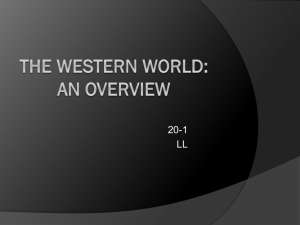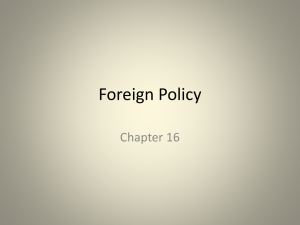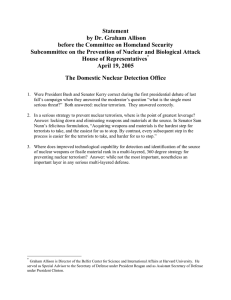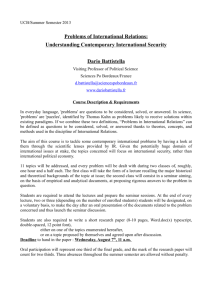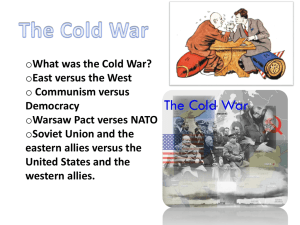AN 499)
advertisement
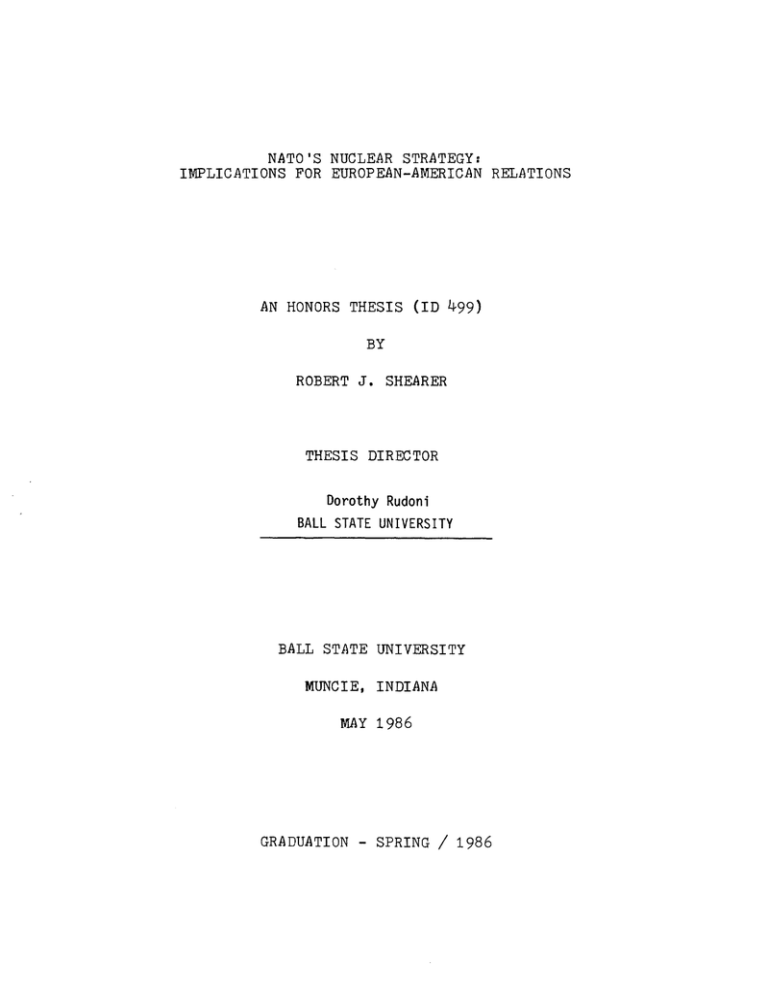
NATO'S NUCLEAR STRATEGY:
IMPLICATIONS FOR EUROPEAN-AMERICAN RELATIONS
AN HONORS THESIS (ID 499)
BY
ROBERT J. SHEARER
THESIS DIRECTOR
Dorothy Rudon;
BALL STATE UNIVERSITY
BALL STATE UNIVERSITY
MUNCIE, INDIANA
MAY 1986
GRADUATION - SPRING / 1986
SpCcli
-[
{, .
Table of Contents
, >'~'-
. r:; 'I
I. Problem
1
II. Review of Related Literature
3
A. The Present Malaise
B.
C.
D.
E.
The
The
The
The
Pershing II and Cruise Deployments
Policy of "No First-Use"
Policy of "Flexible Response"
strategic Defense Initiative
3
5
8
9
11
III. Findings
A. Deployment and Decoupling
B. "Flexible Response" and Conventional Defenses
C. Problems with the strategic Defense Initiative
14
14
IV. Summary and Conclusions
20
V. Bibliography
22
15
17
I
Since 1977, when the initial decision was made to
plan
the deployment of 572 Pershing II and cruise missiles
in European territory, the North Atlantic Treaty Organization (NATO) has found itself mired in arguably the longest
period of controversy over defensive weapons strategy in its
thirty-seven year history.
How has it come to pass that the
Atlantic Alliance finds itself in this situation and what
are the implications for European-American relations?
For almost four decades the Atlantic Alliance has
served as the primary framework for maintaining peaceful
relationships between its members and those states which
constitute the Warsaw Pact.
In that capacity, notwithstand-
ing varied crises and periods of significant stress, NATO
has compiled a track record of enormous achievement.
No
other collective security organization in modern times has
endured for so long in the face of so many obstacles.
theless, NATO cannot rest on its laurels.
Never-
The continued
growth of Soviet military power and the expansionist nature
of that country's foreign policy require that the Alliance
continues to act as a viable means of deterrence.
In this
context, a gradual withering of cohesiveness within NATO, or
worse, a fracture of its basic foundations could be poteBtially ruinous.
Therefore, it is imperative that the current troubles
2
which confront the Alliance be resolved in a manner that is
both expeditious as well as comprehensive.
Not only would
such remedies enhance NATO as a deterrent force, but they
would act to heighten the Alliance's political and economic
position as well.
This discussion will focus primarily on NATO's current defense strategy of "flexible response", the decision
on and eventual deployment of Pershing II and cruise missiles, and the proposed "Strategic Defense Initiative."
After a review of related literature on these topics, the
discussion will turn to their effect on European-American
relations and potential remedial measures.
II
That NATO is now enduring a period of hardship is
largely undisputed.
The extent to which the Alliance's cur-
rent troubles have progressed, however, is a matter which
has been subject to substantial debate.
Lawrence Eagleburg-
er, in an address prepared for the National Newspaper Association, suggested that although there are challenges to be
met by NATO, "It is not my thesis that the North Atlantic
alliance is now in crisis."l
Nevertheless, there are a sig-
nificant number of observers who have stated, for example,
that, "Forces beyond the contol of any statesman, no matter
how skilled or dedicated, have jeopardized the very survival
of the Alliance. ,,2
NATO has experienced difficulties many times in the
past thirty-seven years.
The Suez and Berlin crises of the
1950's, France's withdrawal from the military arm of the
Alliance, and the pressure exerted on its members during the
Vietnam era have all confronted NATO in one form or another
with varying degrees of turmoil.
However, the current dis-
enchantment within the Alliance distinguishes itself from
other periods of trouble in both degree and composition.
1Lawrence S. Eagleburger, "The Transatlantic
Relationship: A Long-Term Perspective," Department of State
Bulletin, 84: 39-42, April, 1984.
2Eliot A. Cohen, "The Long-Term Crisis of the Alliance,"
Foreign Affairs, 61,2 (Winter 1982-1983): 325-343.
4
Writing in The Wilson Quarterly, Kolodziej and
Pollard state,
Americans and their NATO partners have repeatedly
argued over four key issues: military strategy and
nuclear weapons, relations with the Soviets, distribution of defense burdens, and trade and monetary matters. But at no time have these four pro~­
lems afflicted the allies all at once--until now.
While somewhat simplistic in its analysis, Kolodziej and Pollard's suggestion illuminates the depth of the disputes
within the Alliance.
These are problems, however, that can
be solved,
•••• by inelegant but workable compromises; the petty
resentments of the moment will be understood as
such:· fits of pique which lead tn the spats commEn
to any couple, no matter how secure the marriage.
Although important in their own right, the policy
disputes within NATO that have occurred over the last several years take on added significance when they are viewed in
a larger context.
Freedman suggests that,
•••• it remains unclear whether this conjunction of
arguments is a temporary phenomenon brought about
by the strains of recession or by the incompatibility of the current crop of political leaders, or
whether we are witnessing the symptoms of a much
deeper crisis that is unsettling the whole;:.;set:,of
assumptions that have governed Western policymaking over the past three decades. 5
3Edward A. Kolodziej and Robert A. Pollard, liThe
Uneasy Alliance: Western Europe and the United States,"
The Wison Quarterly, 7, 5(Winter 1983): 112-120.
4Cohen, QE. cit., p. 325.
5Lawrence Freedman, "The Atlantic Crisis,
Affairs, 58, 2(Summer 1982): 395-412.
II
International
5
The malaise which NATO now suffers from, and which
according to Freedman is possibly representative of structural problems within the Alliance, originated in large part
with the decision by the United states to attempt to base
intermediate range nuclear weapons in Europe in response to
the deployment of medium range SS-20s by the Soviet Union.
From almost the moment the decision was made, controversy
erupted and to this day is still visible if only in a diluted form.
The December 1979 decision to deploy the missiles
took what was called a "dual.;...track" form.
This involved ne-
gotiating the limitations of nuclear weapons in Europe while
simultaneously preparing to base American Pershing I I and
cruise missiles on European soil.
The logic involved with
this decision was that unless NATO had something to trade
with the Soviets during arms control negotiations it would
be doubtful that Moscow might sacrifice any existing systems.
This approach to arms control would eventually fal-
ter, however, because,
•••• the Eurostrategic weapons began to take on a
life of their own as American officials, who have
lately been excessively running down US defence
capabilities, insisted that NATO required these 6
missiles to plug a gap in the deterrent spectrum.
What this did was to foment much opposition from the Europeans who understandably accused the United States of
6stanley Kober, "Can NATO Survive?" International
Affairs, 59, 3(Summer 1983) p. 341.
6
abandoning the negotiating track of the original decision.
As Bertram points out, putting nuclear weapons programs in
an arms control context makes them more palatable to public
opinion which suggests why,
•••• one of the costly political mistakes of the
early Reagan Administration was precisely to express misgivings about the arms control process and
to contend that only a strengthened West could induce the Soviet Union to accommodate Western security interests. Deterrence by nuclear weapons will
generally only be tolerated by public opinion if it
is accompanied by the search for common constraints
with the Soviet side.?
The other aspect of the Pershing II and cruise missile deployment that acted to cause such controversy was the
nature of the weapons themselves.
These systems, stationed
on European territory, were intended to counter the threat
to that same European soil by the Soviet's SS-20s which by
design were apparently for use against European targets.
This led to the perception that America's European allies
were being "decoupled" from the United State's security
blanket and that the next war could possibly be fought entirely on their soil.
These perceptions were only intensi-
fied in 1981 when President Reagan, responding to a question
as to the possibility of a limited exchange of nuclear weapons between the United States and the Soviet Union, stated,
I don't honestly know ••• I could see where you could
have the exchange of tactical weapons against
troops in the field without it bringing eigher one
of the major powers to pushing the button.
?Christoph Bertram, "Europe and America in 1983,"
Foreign Affairs, 62, 3(Summer 1983) p. 619.
8The New York Times, 21 October 1981, p. A5.
7
Kober suggests, however, that,
The risk of decoupling was probably exaggerated.
Deterrence is the result not of the certainty of
nuclear retaliation, but of the uncertainty that
there will not be retaliation in the event of aggression. Given the destructiveness of the superpowers' huge arsenals, that uncertainty does not
have to be very high to be effective. Thus, if
extended deterrence appears riskier for the United
states in conditions of nuclear parity than it did
before it is still doubtful that the Soviet leadership feels it could unleash an attack against
Western Europe confident that the United states
would refrain from escalating to central nuclear
exchanges, especially in view of the continued
presence of hundreds of thousands of American
troops in Europe.~
Although much consternation has been directed by the
Europeans towards America in general and the Reagan Administration in particular with regard to arms control and the
perceived risk of decoupling, these concerns stem, in large
part, from the nuclear strategy which has been adopted by
NATO.
The excessive reliance on the threat to use nuclear
weapons first in a conflict forces NATO governments
to pretend to be more irrational than they actually
are, and definitely more than they wish to appear
to their public. NATO is caught between the need
to warn the Soviet Union that it might escalate a
conflIct, despite the suicidal implications of such
a move, and to 15assuNthe public that it would not
be so reckless.
The policy that dictates that NATO members might consider the use of nuclear weapons in retaliation to a Soviet
attack was formulated when America's nuclear advantage was
9Kober, QE. cit., p.342
10Lawrence Freedman,"NATO: Tell-and Trust-the People,"
The Times of London, 25 January 1984, p.12.
8
completely overwhelming.
case.
This, however, is no longer the
The nuclear advantage that once was the United
states' has now been transfered to the Soviet Union by a
slight margin.
The general problem with NATO's present defense
strategy is that it is becoming increasingly difficult to
entertain the idea that retaliation in response to a Soviet
attack on Europe could be implemented without a substantial
risk of escalation to nuclear weapons,
Currently, there are
two major schools of thought which have postulated potential
solutions to this problem.
the "Big Four":
The first has been posited by
McGeorge Bundy, George F. Kennan, Robert S.
McNamara, and Gerard Smith.
They have argued that a policy
of "no first-use" of nuclear weapons coupled with a determined build-up of European conventional forces would stabilize the Alliance politically while simultaneously raising
the nuclear threshold.
They state that,
It is time to recognize that no one has ever
succeeded in advancing any persuasive reason to
believe that any use of nuclear weapons, even on
the smallest scale, could reliably be expected to
remain limited. Every serious analysis and every
military exercise, for over 25 years, has demonstrated that even the most restrained battlefield
use would be enormously destuctive to civilian
life and property. There is no way for anyone to
have any confidence that such a nuclear action
will not lead to further and more devastating exchanges. Any use of nuclear weapons in Europe, by
the Alliance or against it, carries with it a high
and inescapable risk of escalation into the general nuclear war Wptch would bring ruin to all and
victory to none.
ll Bundy , Kennan, McNamara, and Smith, "Nuclear Weapons
and the Atlantic Alliance," Foreign Affairs, 60,4(Spring '82)
p.757.
9
The second potential solution to the problem of
NATO's "flexible response" is not a new strategy at all but
merely an augmentation of the current doctrine.
The strate-
gy of "flexible response" allows for three types of retalia-
tion to a Soviet attack:
1) direct defense, 2) deliberate
escalation. 3) general nuclear response.
In the first in-
stance, NATO's conventional forces would defeat a Warsaw
Pact invasion or stifle it to the point where responsibility
for escalation would be shifted to the Soviets.
Deliberate
escalation envisions that NATO. faced with overwhelming
odds, would escalate the conflict through the use of tacticalor theatre nuclear weapons.
The third method of retali-
ation, general nuclear response, would theoretically occur
if Warsaw Pact forces had made expansive breakthroughs of
NATO lines or if the conflict had already risen to the point
of deliberate escalation.
The doctrine was formulated to be
purposely vague so as to force the Soviets to guess which
type of retaliation would occur in response to an attack.
The primary drawback of "flexible response" is that
the primary factor constituting its deterrent is the threat
of escalation.
Although it has already been discussed how
this threat of escalation was intended to be inherent in the
doctrine, the problem arises in that the current status of
NATO's conventional forces render escalation almost a given
rather than a threat.
By most accounts, it would be only a
matter of days before the Warsaw Pact forces had inflicted
enough damage on the Alliance's defenses that escalation
10
would be necessitated unless massive sections of the European landscape were to be sacrificed.
Thus, the present
state of NATO's conventional forces make it not unlikely
that the first respone of direct defense would be bypassed.
One of the more vocal advocates of enhancing the
"C
doct'ine of "flexible response" has been the Supreme Allied
Commander in Europe, General Bernard W. Rogers.
In response
to the present lack of viability of "flexible response's"
first stage, he has proposed that,
There is a more acceptable alternative to
this posture, namely to acquire a conventional
capability that would provide a good prospect of
success in the forward defense of Europe ••• We do
need some increase in numbers of forces to offset
Soviet military growth, but far more important to
success is the enhancement of our ability to do
better with our forces in being and to carry out
the essential modernization of those forces .•• we
need the capability to hold the lead divisions of
a major Warsaw Pact conventional attack while we
conduct an effective interdiction and destruction
campaign with conventional means against its
follow-on forces ••• At the same time, we must have
greater assurance in our ability to control the
sea lanes to Europe and to win the air war over
the continent. 12
Knowing the limitations of "flexible response" without a supplemented conventional deterrent, Rogers has, however, shunned the adoption of the policy of "no first-use."
He has suggested that,
To say that NATO should strive to attain a
conventional posture which would constitute a
credible deterrent to Warsaw Pact conventional
aggression is not to imply that the Alliance
12General Bernard W. Rogers, "The Atlantic Alliance:
Prescriptions for a Difficult Decade," Foreign Affairs, 60,5
(Summer 1982) p.1152-115J.
11
should also now declare a "no-first-use" policy
for its nuclear weapons ••• The single most important factor in restraining Soviet aggression will
always be that chasm of uncertainty about Western
readiness to cross the nuclear threshold ••• even if
we were to develop a conventional defense during
this decade along the lines described, we could
never be certain of success without eventual recourse to nuclear weapons ••• Another inherent danger of declared no-first-use is that many in Europe and the United States would see such a policy
as a limitation on the American commitment to European security. This might well create a situation in which the final guarantor of deterrence
-the U.S. strategic nuclear arsenal- would be
viewed as divorced from the fate of Europe •••
NATO's ability to deter would be jeopardized as
much, or more, by eliminating the flexibility to
escalate than it would by continuing the current
inflexible posture of having to escalate in order
to defend successfully.13
The fear of decoupling, that Rogers suggests would
result from a policy of "no first-use" of nuclear weapons,
has been further exacerbated by President Reagan's Strategic
Defense
Initiative~(SDI).
First presented by Reagan in the
of
Spring of 1983, SDI envisions an array'satellite based lasers and detection devices augmented by land based radars
and high speed missiles.
These systems would act in the
event of a Soviet missile attack as a defensive screen
through which, theoretically, none of the enemy's missiles
could penetrate.
The satellite baaed lasers would destroy
Soviet missiles after they cleared their silos and as they
began to release their individually targeted warheads at the
top of their ballistic arc.
Any warheads that had avoided
the space based lasers would then be tracked and fired upon
by high speed non-nuclear missiles.
13Rogers, £2. cit., p.1153-1154.
12
The theoretical
~ses
of SDI, as the previous de-
scription suggests, have largely been applied to those nuclear systems in which a high trajectory and relatively long
flight time (approximately thirty minutes) allow for the
tracking and targeting of their warheads before they have
reached their targets.
In other words, snI in its primary
formulation would apparently be intended for use solely
against the strategic nuclear arsenals of the Soviets. It is
possible then that,
A 'decoupling' of Europe from the US, with inferior security for Europe could arise from any deployed strategic defense against high-trajectory
missiles like intercontinental and SS-20 ballistic
missiles. This area of SDI research is the most
promising-but its success would leave ground-hugging cruise and low-flying ballistic missiles unchallenged. Since the Soviet Union would presumably imitate within five years or so whatever strategic defense the US developed, such an arrangement
could effectively neutralize the superpowers' arsenals and leave Europe singularly vulnerable to 14
those cruises and short-range ballistic missiles.
The Europeans, as well as many others in the United
States, have expressed concerns that aside from possibly
decoupling Europe from the United States, SDI would alter
the basic status quo of deterrence.
Does not a plan that envisages a world where
nuclear missiles are unable to reach their targets
undermine the whole basis of deterrence and increase the chances of a conventional war in Europe?15
14Elizabeth Pond, "Future of the Atlantic Alliance:
Unity ••• in Diversity?" The Christian Science Monitor, 12
March 1985, p.10-l1.
15Jon Connell,"How 'Star Wars' Could Scuttle Polaris,"
The Sunday Times of London, 26 February 1984, p.21C.
13
SDr has also been faulted for its dependence on laser and detection devices based on satellites.
While ini-
tially the United states space based defense systems would
be impervious to Soviet attack. once Russian antisatellite
(ASAT) technology advanced far enough •
••• the US will be the far greater loser, since it
is far more dependent on satellites for essential
military communication. positioning. surveillance.
and targeting.
Therefore •••• it would be to the West's advantage to negotiate a ban on antisatellite weapons
now before both sides develop such capability.1b
However.
Washington officials believe that since much
of the technology being developed for Asats is
similar to that being studied for anti-missile
systems, a ban on the former would severely restrict research into the latter. Secondly. Asats
are small, and can be easily hidden, so the problems of verifying an Asat ban would be formidable. 7
16Elizabeth Pond, "Europe Fears 'Star Wars' May Destroy,
Not Defend West," The Christian Science Monitor, 12 April
1984, p.38.
-
17Connell, Q£. cit., p.21C.
III
The initial decision to deploy Pershing II and
cp-uise missiles in Europe was in response to a perceived
need to counter what was considered to be a significant disparity between the theatre nuclear forces of the Soviet
Union targeted at Europe and those, or lack thereof, targeted
at the Soviet Union by the Alliance.
The coupling of the
deployment of these systems to the intention that there be
arms control negotiations to reduce such weapons on both
sides was originally intended to make their deployment more
palatable to the public, specifically the Europeans.
Once, however, the plans for deployment had proceeded,
as previously pointed out, they began to take on a life of
their own as American officials concentrated their arguments
on a perceived "window of vulnerability" while ignoring, to
a significant extent, the second track of negotiating their
reduction.
In reality, it was the West Germans who had initiated
the drive for the deployment of the missiles.
The Germans,
however, did not wish this posture to be thrashed about in
public in view of the strong anti-nuclear sentiments in
their country.
The United States, nevertheless, wishing to
show that they were not the only hawks in the Alliance pressured the Germans to go public.
The Soviets on the other
15
hand were pressuring the Germans with threats of ending detente and starting a new arms race.
The Germans, in trae
Hamlet form, would eventually make no decision save for announcing that deployment should be linked to arms negetiations and stating that they would deploy only if another
continental European nation would accept the missiles thereby transferring much of the pressure away from them,18
The deployment proceedings after that point bogged
down in the political controversy in Belgium, Holland, and
Italy whose publics were less than enthused about their governments receiving new nuclear weapons.
Once Germany had
shifted the decision to deploy away from themselves, it was
the United states who began to take the brunt of the criticism being the other party most eager to begin deployment.
Bertram points out that,
While it is possible that future West European
governments will ask for a more defined responsi~ility in America's nuclear decisions, it is not
very likely; more probably, they will want to return to the convenient position of supporting u.s.
nuclear decisions without being accountable for
them ••• While it may not be sufficient as a durable
formula for Alliance nuclear diplomacy in the future, i t is at least politically acceptable in
Europe. 1 9
The NATO defense rtoctrine of "flexible response" illuminates one of the Alliance's more serious dilemmas.
It
is largely agreed upon that for "flexible response" to be a
18Pierre Lellouche,"Europe and Her Defense," Foreign
Affairs, 59,4(Spring 1981) p.822.
19ChristoPh Bertram, "The Implications of Theatre
Nuclear Weapons in Europe," Foreign Affairs, 60,2(Winter
1981-1982) p.)l).
16
more viable defense doctrine, NATO's conventional defense
forces must be enhanced significantly.
Why then doesn't
the Alliance make a concerted effort to supplement them?
Senator Sam Nunn suggests that,
•.•. First, the conventional force gap beween NATO
and the Warsaw Pact has been described as so large
for so long that a viable conventional defense is
believed by many to be hopeless. Second, the cost
of matching Warsaw Pact forces one for one-in tanks
troops, artillery, and aircraft-is seen as prohibitive, ~articularly under current economic conditions. 2D
The Europeans are not likely, even with pressure
from the United States, to increase their defense commitments to NATO by a sUbstantial margin.
Proposals made by
General Bernard Rogers to achieve this enhancement would require a commitment to defense of
through 1988 over the current
3%
4%
of annual real growth
by all NATO members. 21
It has been suggested that the United States could
attempt to force the Europeans to make spending increases
by threatening to withdraw U.S. troops or by adopting a "no
first-use" policy.
To resort to either of these extremes
would leave the Europeans open to Soviet conventional aggression which could in turn put the United States in a position
in which they would be forced to use nuclear weapons or sacrifice their NATO allies.
20Senator Sam Nunn, Report to the Committee on Armed
Services, United States Senate,"NATO= Can the Alliance Be
Saved?" Atlantic Community Quarterly, 20,2(Summer 1982)p.128.
21 Nunn, Q2. cit., p.132.
17
It is becoming increasingly apparent, as the United
States' global interests become greater and the current
shift in interest towards the Pacific Basin continues, that
Europe must begin to assume more responsibility for its own
defense.
The Europeans are going,
••• to have to face an increasingly unfavorable situation given 1) the growing Soviet capacity to
launch a surprise attack, and 2) the tendency on
the part of the United States to move forces and
equipment out of Europe for contingencies arising
in Third World regions(in particular, the Persian
Gulf area). Improving the conventional military
balance between East and West will imply, at the
outset, that a number of financial~ and therefore
political choices have to be made.~2
Nevertheless,
••• in the absence of political will among key European nations to take their security into their own
hands, it is hard to see how an autonomous European
security entity could be established, even in the
very long term. 2 3
The Strategic Defense Initiative, of all the current
topics associated with NATO, is probably the most controversial.
The risk of Europe being decoupled from the United
States' nuclear guarantee, the huge costs associated with
the project, and the lingering doubts concerning the program's ability to achieve its intended use all function to
make SDI the most potentially divisive issue in NATO history.
The Reagan Administration has done little to calm
22
Lellouche, £E. cit., p.8]O.
2JIbid., p.828.
18
Europe's fears of decoupling aside from making bland pronouncements as to how the finished product will protect Europe as well as the United States.
European concerns are un-
derstandable when the program is termed the Strategic Defense Initiative and the words "tactical" or "theatre" are
totally excluded.
The most disturbing thought concerning SDI is that
while billions of dollars are slotted to be spent on its development,
••• no one with whom I have talked honestly believes
that we can ever achieve the President's fanciful
objective of-to use his language-rendering the
Soviet missile force -impotent and obsolete.' A
few months ago during a private conversation with
the administration official who, probably more than
any other, provides the intellecmual impetus for
the star wars project, I asserted that the President's objective was pure fantasy. He replied: 'Of
course we all know that. We're embarrassed by it,
and we wish he'd start playing a different record.
Obviously, we can't hope to build a system that
will safeguard American cities or protect the American population, but we should be able to shield at
least some of our own nuclear arsenal. We should
be able to stop a sUbstantial percentage of the
Soviet's nuclear weapons from reaching their targets.
To that I replied, 'Well, if that's all you
hope to accomplish, then the proposal as represented is fraudulent; it is in realistic terms nothing
more than a stimulus to escalation; Moscow will
have to augment its nuclear arsenal by a factor of
'X' to enable it to launch enough weapons to ensure
that the critical minimum gets through. Then we'll
have to match that escalation.'
At that poi~E he terminated the conversation,
turned and left.
24George W. Ball,"Reagan's Ramboism-the Fantasy of Star
Wars and the Danger of Real Wars," The Christian Science
Monitor, 28 April 1986, p.18.
19
If a high administration official admits that a substantial portion of the rhetoric that the President has been
delivering to his European counterparts is duplicitous and
largely false, it can only be assumed that the great sums of
money the European governments are spending on SnI research
will, in the end, only work to promote that decoupling to
which they have expressed so many fears and only place more
of a strain on the Alliance than that which exists already.
IV
The purpose of this study was to research the reasons
for the current problems associated with NATO's defensive
doctrine and to see what implications there would be for
European-American relations.
The discussion revealed that the Alliance's troubles
had arisen in their most earnest form after the initial procedures to deploy Pershing I I and cruise missiles.
The rea-
son for this disenchantment was linked to the European's perceptions that these deployments would decouple them from
America's strategic nuclear arsenals and that arms control
negotiations which were to coincide with the deployment were
being largely ignored.
The study also showed that NATO's doctrine of flexible response lacked credibility without a solid conventional arm.
Without this conventional deterrent, flexible re-
sponse became inflexible and instead of threatening escalation it almost assumed it.
Thirdly, the discussion pointed out some of the problems associated with the Strategic Defense Initiative.
primary drawbacks with this program are:
The
1) its threat to
decouple Europe from the United States, 2) its huge costs,
3) its lack of viability as a useful strategic deterrent.
The Atlantic Alliance can overcome the problems associated with its defense strategies but its policy-making
21
must first become more coherent.
The disarray that coincided
with the deployment of the Pershing II and cruise missiles
must be avoided in the future.
The continued implementation
of divisive policies like this one will only work to drive
the wedge deeper between Alliance members.
NATO's conventional forces must be enhanced or flexible response will always lack the viability of a strong deterrent strategy.
As the interests of the United States
turn elsewhere, it is imperative that Europe begins to supplement here own conventional defenses.
The lack of either
of these two prescriptions will render NATO's long-term future problematic in that there would have to be a continuing
overemphasis on the United states nuclear guarantee.
Finally, the Strategic Defense Initiative should be
placed under the closest scrutiny.
A program that is pur-
ported to protect European interests but in reality does
not should be viewed with the utmost suspicion.
Whatever
research benefits that could be derived from the program
should be weighed carefully against the potentially enormous
costs, politically,economically, and foremost, militarily.
22
Bibliography
Ball, George W. "Reaganls Ramboism-the Fantasy of star Wars
and the Danger of Real Wars." The Christian Science
Monitor, 28 April 1986, p. 18.
Bertram, Christoph. "Europe and America in 1983."
Affairs, 62, 3 (Summer 1983)= 616-631.
Foreign
Bertram, Christoph. "The Implications of Theatre Nuclear
Weapons in Europe." Foreign Affairs, 60, 2 (Winter 19811982): 305-326.
Bundy, McGeorge, et ale "Nuclear Weapons and the Atlantic
Alliance." Foreign Affairs, 60, 4 (Spring 1982)= 753768.
Cohen, Eliot A. "The Long-Term Crisis of the Alliance."
Foreign Affairs, 61, 2 (Winter 1982-1983): 325-343.
Connell, Jon. "How 'Star Wars' Could Scuttle Polaris."
Sunday Times of London, 26 February 1984, p. 21C.
The
Eagleburger, Lawrence S. "The Transatlantic Relationship: A
Long-Term Perspective." Department of State Bulletin,
84 (April 1984): 39-42.
Freedman, Lawrence. "NATO: Tell-and Trust-the People."
Times of London, 25 January 1984, p. 12.
The
Freedman, Lawrence. "The Atlantic Crisis." International
Affairs, 58, 2 (Summer 1982): 395-412.
Kober, Stanley. "Can NATO Survive?"
59, 3 (Summer 1983): 339-349.
International Affairs,
Kolodziej, Edward A. and Robert A. Pollard. "The Uneasy
Alliance: Western Europe and the United States." The
Wilson Quarterly, 7, 5 (Winter 1983): 112-120.
Lellouche, Pierre. "Europe and Her Defense."
59, 4 (Spring 1981): 813-834.
Foreign Affairs,
Nunn, Senator Sam. "NATO: Can the Alliance Be Saved?" A
Report to the Committee on Armed Services, Atlantic
Community Quarterly, 20, 2 (Summer 1982): 126-138.
Pond, Elizabeth. "Future of the Atlantic Alliance: Unity •••
in Diversity?" The Christian Science Monitor, 12 March
1985, p. 10-11. Pond, Elizabeth. "Europe Fears 'Star Wars' May Destroy, Not
Defend West." The Christian Science Monitor, 12 April
1984, p. 1, 38.-
Bibliography
23
Rogers, General Bernard W. "The Atlantic Alliance:
Prescriptions for A Difficult Decade." Foreign Affairs
60, 5 (Summer 1982): 1145-1156.



